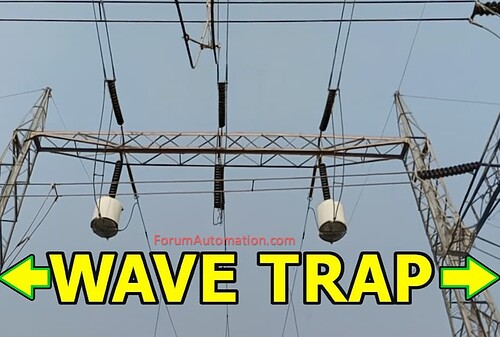What is a Wave Trap (Line Trap) in Power Systems?
A wave trap, also known as a line trap, is a key component used in high-voltage transmission lines to enable Power Line Carrier Communication (PLCC) between substations. It enables the same transmission line to transport electrical power & communication signals without interference.
Function of Wave Trap
A wave trap’s principal function is to prevent high-frequency communication signals (usually in the range of 30 kHz to 500 kHz) from entering undesirable areas of the power network while allowing 50/60 Hz power frequency to pass via undisturbed. These high-frequency transmissions are utilized for teleprotection, voice communication, remote control and inter-substation telemetry.
Working Principle of Wave Trap
A wave trap functions as a band-stop filter (also known as a blocking filter). It consists of inductors, capacitors & resistors that are tuned to the communication carrier frequency spectrum.
When PLCC signals go down the transmission line, the wave trap creates a high impedance path for the carrier frequency essentially preventing it from flowing to other portions of the power system.
However, it has a low impedance at the 50/60 Hz power frequency allowing normal power transmission to proceed without interruption.
Features of Wave Trap
The main coil provides inductive reactance, which blocks carrier frequencies.
Tuning Device (Capacitor Unit): Adjusts the circuit to the appropriate frequency range.
Bypasses strong transient currents to protect the trap during switching (or) lightning surges.
Mechanically secures the wave trap to the transmission line (or) substation tower.
Advantages of Wave Trap
Enables secure communication over existing transmission lines.
Removes the requirement for individual communication cables.
Provides real-time relay protection & control.
Ensures the safe and interference-free functioning of PLCC systems.
Applications for Power Systems
Wave traps are widely installed at substation line terminals, usually between the bus and the line coupling capacitor (CC) in a PLCC configuration. They are useful for:
Power Line Carrier Communication (PLCC).
Distance & differential protection signals
Telemetry & Remote Control
Voice and data communication between substations.
You can also follow us on AutomationForum.co, Facebook and Linkedin to receive daily Instrumentation updates.
You can also follow us on ForumElectrical.com , Facebook and Linkedin to receive daily Electrical updates.
